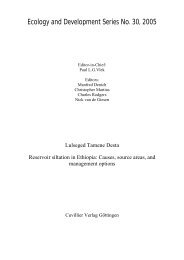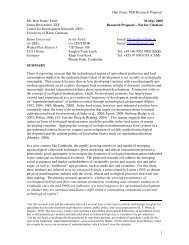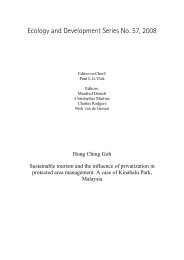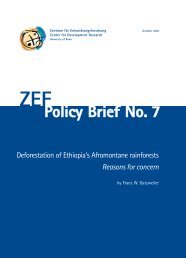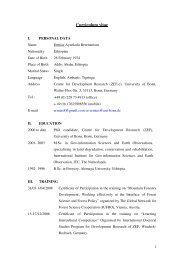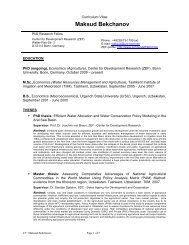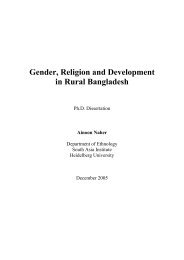Ecology and Development Series No. 10, 2003 - ZEF
Ecology and Development Series No. 10, 2003 - ZEF
Ecology and Development Series No. 10, 2003 - ZEF
- No tags were found...
You also want an ePaper? Increase the reach of your titles
YUMPU automatically turns print PDFs into web optimized ePapers that Google loves.
Floristic analysis of the undisturbed forestof the total abundance is contributed by only three species (Rank order 1-3, Table 4.1), <strong>and</strong>nearly 99% of the total abundance is accounted for by half of the total number of species(Rank 1-51, Table 4.1). The five most abundant <strong>and</strong> common trees in the canopy layer areDiospyros abyssinica, Albizia gr<strong>and</strong>ibracteata, Blighia unijugata, Trichilia dregeana <strong>and</strong>Celtis africana, while most dominant trees in the lower stratum are Dracaena fragrans,Coffea arabica, Argomuellera macrophylla, Canthium giordanii <strong>and</strong> Clausena anisata.Among the climbers, the most dominant ones are L<strong>and</strong>olphia buchananii, Paulliniapinnata, Hippocratea africana, Tiliachora troupinii <strong>and</strong> Combretum paniculatum, while thedominant shrubs include Maytenus gracilipes, Justicia schimperiana, Rhus ruspoli, Justiciabetonica <strong>and</strong> Phyllanthus ovalifolius.A relatively small number of species were widespread in the forest, with only 23occurring in more than 50% of the plots. At the other extreme, 17 species were recordedonly once (frequency 1.7%), while 38 species occurred in fewer than five plots. Localabundance (the average number of individuals of a species in the plots where it occurred)varied widely. Dracaena fragrans, Coffea arabica, Argomuellera macrophylla, L<strong>and</strong>olphiabuchananii <strong>and</strong> Justicia betonica had the highest local abundance, in descending order(Table 4.1). On the other h<strong>and</strong>, many species are rare even in the plots where they occur.Twenty-one of the <strong>10</strong>2 species found in the sample plots have average local abundancevalues of less than 5 individuals, while 64 plant species had the mean abundance of lessthan 5 individuals per plot. Seven species, namely: Schefflera abyssinica, Apodytesdimidiata, Ficus mucuso, Aningeria altissima, Celtis zenkeri, Stereospermum kanthianum<strong>and</strong> an unidentified tree specie (Genus7 sp.) had only one individual in just one sampleplot.42





